Timeline: Palestine since 1915
A review of important events in Palestine since World War I.
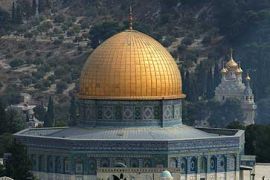
 |
| Palestinians say their nation has been occupied for the past 60 years [GALLO/GETTY] |
No country in the Arab World conjures up as much anger and passion in the Arab psyche than Palestine. Palestinians say it is nation of cultures and religions bound together by history and inalienable rights.
Israelis say Palestine is a part of land that has been inherently bequeathed to them by God.
Religion and culture have often intermixed with colonial influence and the Cold War with deadly effect.
Since 1948, and again in 1967, millions of Palestinians have been driven from their homes and live in squalor in refugee camps which festoon the Arab World.
In Palestine and Israel violence continues to drown any hopes of a negotiable peace deal to bring stability, security and a just peace to the region.
Suicide attacks carried out by armed groups against Israeli military and civilian targets and the killing of thousands of Palestinians by the Israeli military in the past decade have embittered both sides and created nearly unwavering distrust.
But the roots of the conflict pre-date the UN mandate which led to the creation of Israel in 1948.
1915-1916: Hussein-McMahon correspondence. Exchange of letters between Sherrif Hussein ibn Ali, ruler of Mecca and the Hejaz, and Sir Henry McMahon, the British high commissioner in Egypt, regarding the future political status of the Arab lands of the Middle East, with Britain aiming to bring about an armed revolt against Ottoman rule.
McMahon, in his second letter of October 24, 1915, writes: “The districts of Mersin and Alexandretta, and portions of Syria lying to the west of the districts of Damascus, Homs, Hama and Aleppo, cannot be said to be purely Arab, and must on that account be excepted from the proposed delimitation.
“Subject to that modification, and without prejudice to the treaties concluded between us and certain Arab chiefs, we accept that delimitation.
“As for the regions lying within the proposed frontiers, in which Great Britain is free to act without detriment to interests of her ally France, I am authorised to give you the following pledges on behalf of the Government of Great Britain, and to reply as follows to your note:
That subject to the modifications stated above, Great Britain is prepared to recognise and uphold the independence of the Arabs in all the regions lying within the frontiers proposed by the Sharif of Mecca.”
May 16, 1916: Sykes-Picot Agreement. Britain and France sign a secret pact outlining their spheres of control in the Middle East after the first world war. Palestine is designated for international administration pending consultations with Russia and other powers. The agreement is seen by Arabs as a betrayal of the Hussein-McMahon correspondence.
November 2, 1917: Balfour Declaration. Arthur James Balfour, Britain’s foreign secretary, sends a letter to Lord Rothschild, president of the Zionist federation, stating the government’s support for the establishment of “a national home for the Jewish people” in Palestine, the area consisting of today’s Israel, the West Bank, Gaza Strip and Jordan.
The declaration reads: “His Majesty’s Government view with favour the establishment in Palestine of a national home for the Jewish people, and will use their best endeavours to facilitate the achievement of this object, it being clearly understood that nothing shall be done which may prejudice the civil and religious rights of existing non-Jewish communities in Palestine, or the rights and political status enjoyed by Jews in any other country.”
1918: In the aftermath of the war the sons of Hussein were made the kings of Transjordan (later Jordan), Syria and Iraq.
July 24, 1922: The League of Nations gives Britain a mandate to administer Palestine. Britain expresses an interest in Zionism, and describes its intention to develop a Jewish state.
1929-1939: In large part because of the rise of fascism in Europe, about 250,000 Jews arrive in Palestine during this period.
August 23: Arab rioters kill 67 Jews in Hebron.
1930-35: Violent activities of Black Hand Islamist group led by Sheikh Izz al-Din al-Qassam against Jewish civilians and the British.
July 22, 1946: Bombing of the King David Hotel in Jerusalem, which housed the British civil, military and police command in Palestine, by members of Irgun, a Zionist organisation. Ninety-one people are killed, 28 British, 41 Arab, 17 Jewish and five from other countries.
November 29, 1947: United Nations general assembly passes a partition plan dividing the British Mandate of Palestine into two states. Accepted by the Jewish leadership but rejected by the Arab leadership.
1947-1949: The Nabka, meaning “disaster” or “cataclysm” in Arabic. Up to 900,000 Palestinians flee or are expelled from their homes in the part of the land that becomes the state of Israel.
April 9, 11, 1948: Deir Yassin massacre. Between 100 and 254 Palestinian villagers, mainly women, old people and children are killed during and after an attack on the village of Deir Yassin near Jerusalem by Irgun members.
May 15: Declaration of Israel as the Jewish state. British withdraw from Palestine. Arab-Israeli war. Egypt, Syria, Jordan, Saudi Arabia, Iraq and Lebanon declare war on Israel. Egypt, Jordan and Syria invade Israel.
April, 1949: Israel and Arab states agree an armistice. Israel has taken about 50 per cent more land than was originally allotted to it by the UN partition plan.
1956: Egypt nationalises Suez Canal (July 26). France, Britain and Israel plan invasion of Egypt. Israel invades the Sinai peninsula (October 29). Pressure from the US and USSR force France, Britain and Israel to withdraw.
May, 1964: The Palestine Liberation Organisation (PLO) is founded in Cairo by the Arab League. The PLO states its goal as the destruction of the Israel through armed struggle, and the restoration of an “independent Palestinian state” between the Jordan river and the Mediterranean sea.
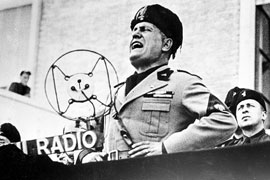
The rise of fascism in Europe led large
numbers of Jews to flee to Palestine

The rise of fascism in Europe led large
numbers of Jews to flee to Palestine
June, 1967: Six Day war. Israel launches a pre-emptive attack on Egypt, Syria and Jordan. Israel captures Sinai Peninsula and Gaza Strip from Egypt, the Golan Heights from Syria and the West Bank and East Jerusalem from Jordan. In this year, Israel begins settlement programme in areas captured during the Six Day war.
1968-1970: War of Attrition. Limited war fought between Egypt and Israel in which Egypt attempts to regain the Sinai Peninsula lost in the Six Day war. The war ended with a ceasefire in August 1970 with the same frontiers as at the start.
February 2, 1969: Yasser Arafat is appointed chairman of the PLO.
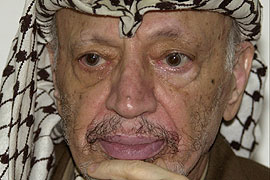 |
|
Yasser Arafat led the Palestine Liberation Organisation for 25 years |
1972, September 5: Eleven members of the Israeli Olympic team and one German police officer are killed by Palestinian group Black September at the Munich Olympics.
October 6, 1973: Yom Kippur war (October war). In a surprise attack on the Jewish Day of Atonement, Egypt and Syria retake the areas in Sinai and the Golan Heights that were lost in the Six Day war. Despite initial gains they are soon forced to retreat by Israeli forces.
September 17, 1978: Menachem Begin, Israel’s prime minister, and Anwar Sadat, Egypt’s president, sign the Camp David Accord, with Israel agreeing to withdraw from the Sinai Peninsula in exchange for peace and a framework for future negotiation over the West Bank and Gaza Strip.
March 26, 1979: Peace deal between Egypt and Israel. Egypt becomes the first Arab country to recognise Israel. Later in this year, Arab League suspends Egypt’s membership of the league following Egypt’s peace agreement with Israel. The organisation moves its headquarters to Tunis.
October 6, 1981: Sadat is assassinated by members of the Egyptian Islamic Jihad organisation, while reviewing a military parade, in retaliation for Sadat’s recognition of Israel.
June 6, 1982: Israel invades Lebanon to remove PLO fighters who it says are threatening its border. PLO relocates to Tunis as it is driven out of Lebanon by Israel during the six-month invasion of the country. Remains active in Lebanon but not to the same extent as before 1982.
September, 1982: Sabra and Shatila massacre. Lebanese Phalangists (members of a Christian paramilitary group) kill up to 2,750 Palestinians in the Palestinian refugee camps of Sabra and Shatila.
August, 1983: The Israeli army withdraws from most of Lebanon, maintaining a self-proclaimed “security zone” in the south.
September 25, 1985: Three Israelis are killed on their yacht off the coast of Larnaca, Cyprus, by Force 17, a commando group from Fatah, the largest organisation in the PLO.
October 1: Israel’s Operation Wooden Leg attempts to kill Arafat with an air raid on his headquarters in Tunis. He survives, but 60 members of the PLO are killed including much of the leadership.
December 8, 1987: First intifada (uprising) starts. Palestinians begin general strikes, riots and civil disobedience campaigns across the West Bank and Gaza Strip. Israeli army replies with tear gas, plastic bullets, and live rounds. Sheikh Ahmed Yassin creates Hamas from the Gaza wing of the Egyptian Muslim Brotherhood.
November 15, 1988: PLO, from its base in Tunis, unilaterally proclaims a State of Palestine.
October, 1991: Middle East peace conference opens in Madrid.
September 13, 1993: Oslo declaration of principles. PLO and Israel agree to recognise each other.
February 25, 1994: Baruch Goldstein, an American-Israeli settler, enters the Cave of the Patriarchs, a religious site in Hebron, and kills 29 Palestinians, injuring another 125.
October 26: Israel and Jordan sign a peace treaty ending 45-years of hostility. Israel agrees to recognise the special role of Jordan over Muslim holy sites in Jerusalem.
November 4, 1995: Yitzhak Rabin, Israel’s prime minister, is assassinated by Yigal Amir, an Israeli orthodox Jewish student who is against the Middle East peace plan. Shimon Peres takes over as prime minister.
July, 2000: The Camp David summit between Ehud Barak, Israel’s prime minister, and Arafat, the chairman of the Palestinian Authority, aimed at reaching a “final status” agreement ends after Arafat refuses to accept a proposal drafted by US and Israeli negotiators.
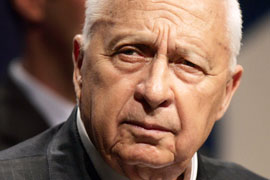 |
|
Ariel Sharon was elected leader of the Likud party on February 6, 2001 |
September: Palestinians riot after Ariel Sharon, of the Likud party in Israel, visits the Temple Mount in Jerusalem. Second initifada begins.
February 6, 2001: Sharon is elected the leader of Likud and refuses to continue negotiations with Arafat.
June 1: A Hamas suicide bomber attacks a nightclub. Twenty-one Israelis killed, mainly teenagers, more than 100 injured.
October 17: Rehavam Zeevi, Israel’s tourism minister, is shot dead in Jerusalem by members of the Popular Front for the Liberation of Palestine.
December: Sharon sends troops into Ramallah shelling and surrounding the Palestinian government’s West Bank headquarters; Arafat is unable to leave.
March, 2002: Israeli army launches Operation Defensive Shield, the country’s biggest military operation in the West Bank since the Six Day war in 1967. In the same year, Israel begins construction of separation barrier between the West Bank and Israel, but for some of its length it serves to annex large areas of Palestinian land.
March 27, 28: Beirut summit between heads of Arab nations to discuss plans to resolve the Palestinian-Israeli conflict. Arafat is unable to attend as Israel will not guarantee he will be able to return.
Arab leaders collectively offer Israel peace, recognition and normal relations in return for Israel’s withdrawal from Arab lands captured since 1967, the restoration of a Palestinian state with east Jerusalem as its capital and a “fair solution” for the 3.8 million Palestinian refugees.
March 22, 2004: Sheikh Yassin, the co-founder and leader of Hamas, is assassinated by an Israeli helicopter gunship.
April 17: Abd al-Aziz al-Rantissi, the co-founder of Hamas and successor to Yassin, is killed by the Israeli army.
July 9: International Court of Justice rules that the Israeli separation barrier violates international law and must be removed.
November 11: Arafat dies.
January 9, 2005: Mahmoud Abbas is elected president of the Palestinian National Authority.
January 10: Sharon creates government of unity with Labour and United Torah Judaism parties.
August: Completion of Israel’s unilateral disengagement plan from Gaza and four West Bank settlements.
January 25, 2006: Hamas wins a majority of seats in the Palestinian legislative election. The US, Israel and several European countries cut off their aid to the Palestinians as the party rejects Israel’s right to exist.
June 25: Palestinians cross the border from the Gaza Strip and capture Corporal Gilad Shalit, killing two Israeli soldiers and wounding four others.
September: Violence erupts between Fatah and Hamas parties in the Gaza Strip. Abbas attempts to prevent civil war. Abbas’s Fatah movement supports a Palestinian state alongside Israel, while Hamas rejects Israel’s right to exist.
October 1: Eight people are killed in Gaza in factional infighting between Hamas and Fatah as a new wave of violence erupts.
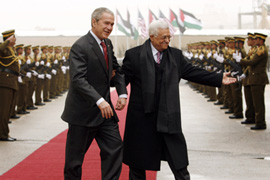 |
| Mahmoud Abbas, right, is often portrayed by the West as the Palestinian face of moderation |
October: A number of mediation conferences are held. Egypt and Qatar send their foreign ministers to meet with both sides. Other Palestinian groups like the Islamic jihad and the Popular Front for the Liberation of Palestine mediate between the two sides to stop the clashes.
November 13: Following talks between Hamas and Fatah, both sides agree to form a unity government unaligned with either movement. Muhammad Shbeir, a Gaza academic who is close to Hamas but not a party member accepts, the offer to head the government.
December 15: Hamas accuses Fatah of involvement in a gun attack on Ismael Haniya, Palestinian prime minister, as he crosses the border from Egypt into Gaza.
December 16: Abbas calls for new elections as a solution to the ongoing crisis.
January 21, 2007: Abbas meets Khaled Meshaal of Hamas in Damascus in response to an invitation by Bashar Al-Assad, the Syrian president.
January 30: Fatah and Hamas reach a ceasefire agreement mediated by Egypt after a series of clashes that lead to the death of 32 Palestinians. Both sides welcome a Saudi initiative to meet in Mecca.
February 8: Hamas and Fatah agree on a deal in Mecca to end factional warfare that has killed scores of Palestinians and to form a coalition, hoping this would lead Western powers to lift crippling sanctions imposed on the Hamas-led government.
February 9: The Quartet welcomes the role of the Kingdom of Saudi Arabia in reaching the agreement to form a Palestinian National Unity government but later reaffirms that it must obey international demands to recognise Israel, renounce violence and abide by previous peace agreements.
February 15: Ismail Haniya and his cabinet resign. Haniya is re-appointed by President Abbas and begins the process of forming a new Palestinian unity government.
March 15: Palestinians reach agreement on the formation of the government.
March 17: The new Palestinian unity government holds its first cabinet meeting in Gaza City, with ministers in the West Bank participating from Ramallah via video link.
March: Israel refuses to talk to the coalition, saying it fails to meet international demands – renouncing violence, recognising Israel and honouring past peace deals.
March: Hamas-Fatah violence erupts in Gaza, leaving one Fatah fighter dead, and seven people wounded, in the first deadly clash between the two groups, since the unity government was formed.
March: Ehud Olmert, the Israeli prime minister, describes Ismail Haniya, his Palestinian counterpart and senior Hamas leader, as a “terrorist”.
April: Israel plans Gaza invasion, a day after Ehud Olmert, Israeli prime minister, calls for a regional peace conference with Arab states.
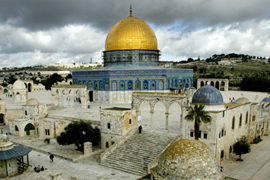 |
| The Dome of the Rock is considered one of the holiest sites in Islam [AP] |
April: The US gives Mahmoud Abbas, the Palestinian president, $60m to boost his presidential guard and for other security expenses. The money would also be used for security improvements at Gaza‘s main commercial crossings with Israel, for logistics and communications equipment, and other security expenses.
Several US legislators had held up the money, fearing it could reach Hamas, which formed a unity government with Abbas’s Fatah party after months of negotiation.
May: Israel presses ahead with air raids on Gaza, launching five attacks after dark. The strikes came after Ehud Olmert, the prime minister, said that Israel would continue its crackdown on Hamas following Qassam rocket attacks on Sderot that killed one Israeli civilian and injured one.
June: Hamas issues Gaza arms ultimatum and tightens its grip and control on the territory. Abbas issues new government, and announces Salam Fayyad, an economist, as the emergency government head. Abbas swears in new emergency government, by passing Hamas.
June: Palestinian aid embargo lifted. The US and the European Union resume aid to Palestine. Abbas announces it is time to resume peace talks with Israel.
November: George Bush, US president, hosts peace talks between Palestine and Israel at Annapolis, Maryland, while Hamas still holds control over Gaza.
January, 2008: Israel steps up military actions on Gaza and Hamas, killing seven Palestinians. Olmert vows to hit back after Hams rocket attacks in Israel. Israel continues powerful incursion on Gaza, leaving Palestinians in a humanitarian crisis without fuel, power, food and water.
Palestinians blow up part of the border at Rafah, going into Egypt. The border breach came several days after Israel had imposed a complete blockade on Gaza, with Egyptian backing, in response to a rocket barrage from Gaza on Israeli border towns.
Ismail Haniya, Hamas leader and one-time prime minister, has meanwhile said the group would not allow the border to be resealed. The border crossing had been opened on the orders of by Hosni Mubarak, the Egyptian president. It had allowed Palestinians trapped in Gaza to purchase important basic necessities that were unavailable due to the Israeli blockade.